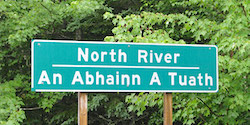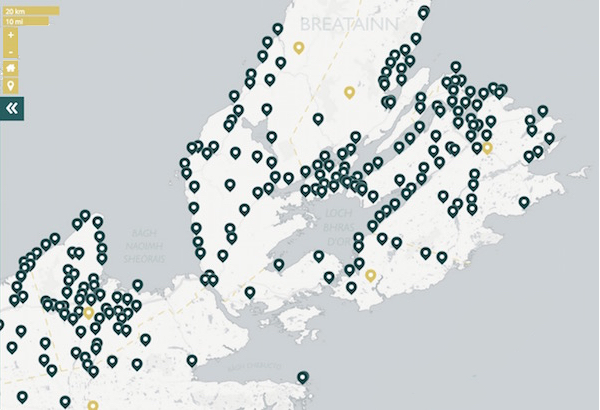10 May Those Gaelic road signs: an interactive map, and a few questions
Comhairle na Gáidhlig, a.k.a. The Gaelic Council of Nova Scotia, has teamed up with Heather Smith of the Centre of Geographic Sciences in Lawrencetown to produce an interactive map of Gaelic place names in eastern Nova Scotia and Cape Breton.
Clicking on the image above will take you to the interactive version. There you can hover your cursor over the tear-shaped place-markers to call up the Gaelic name of each location. Clicking the place-markers brings up the Gaelic name, the English name, the county, and a tiny sound file of the Gaelic pronunciation. Nice use of mapping.*
 I confess to both skepticism and ambivalence about these Gaelic road signs: Skepticism about their authenticity—are these really the names Gaelic-speaking settlers used two centuries ago, or are they merely Gaelic translations of 20th Century English place names? (To judge from the map, they’re about half and half.)—and ambivalence about the fraudulent conceit that Nova Scotia is, in any meaningful sense, “New Scotland.”
I confess to both skepticism and ambivalence about these Gaelic road signs: Skepticism about their authenticity—are these really the names Gaelic-speaking settlers used two centuries ago, or are they merely Gaelic translations of 20th Century English place names? (To judge from the map, they’re about half and half.)—and ambivalence about the fraudulent conceit that Nova Scotia is, in any meaningful sense, “New Scotland.”
That issue has been most authoritatively plumbed by Queens University folklorist Ian McKay, first in a paper published in the journal Acadiensis, and later fleshed out in a brilliant book, The Quest of the Folk: Antimodernism and Cultural Selection in Twentieth-Century Nova Scotia, which ought to be on every Nova Scotian’s reading list. In Acadiensis, McKay wrote:
A great number, although by no means all, of the Scots who came to Nova Scotia between 1770 and 1840 were Highlanders. Many settled in the province’s northern counties, particularly in Pictou and Antigonish counties on the mainland, and on Cape Breton Island…. The Gaelic language was imported by the Scots and spoken in many parts of the northern counties, particularly in rural Cape Breton. Sermons were commonly preached, and numerous books and periodicals published, in that language. Spoken by at least 24,303 Nova Scotians, according to the 1931 census, Gaelic was an important language in the province….
However, none of this evidence of Scottish settlement made Nova Scotia a “Scotland of the New World.” According to the 1921 census, the 148,000 Nova Scotians of “Scottish origin” represented just over 28 per cent of the provincial population of 523,837. They were outnumbered by 202,106 Nova Scotians of “English origin,” representing about 39 per cent of the total population. The remaining 173,731 Nova Scotians were assigned a wide range of “principal origins” by the census: Irish, French (i.e. Acadian), German, Black, “Indians,” and others. Not only was Nova Scotia not predominantly Scottish, but it was also not the most Scottish of Canadian provinces: Prince Edward Islanders of Scottish origin accounted for a larger percentage of their province’s population; 465,400 Ontarians of Scottish origin were about three times more numerous than those of Nova Scotia….
Nova Scotia “became Scottish” in the second quarter of the 20th century. Before then, no single vocabulary of “Nova Scotianness” was in use. Somehow, in little over three decades, a collection of hazy generalizations and ethnic stereotypes about Nova Scotians was transformed into a natural and obvious “commonsense” about Nova Scotia’s identity. Why was tartanism triumphant? The broad answer is that it was part of an international anti-modernist wave, a local version of a general middle-class search for something outside and better than the crisis-ridden modern world it inhabited. The narrow answer is that tartanism was triumphant because Premier Angus L. Macdonald, convinced of certain self-evident truths—the truths of his own particularly romantic and essentialist reading of the Scottish tradition, and of the redemptive role of tourism—used the state’s cultural power to fuse these two truths into one commanding commonsense.
I have fond memories of the Gaelic-reared elders who enriched and guided my first years in Cape Breton, but we risk selling short the rich mix of cultures—Yiddish, Caribbean, Eastern European, Newfoundlander, South Asian, Yankee, African-American, Mi’kmaq, Acadian, English, and Hessian—who contributed to modern Nova Scotia. To say nothing of the Farsi, Mandarin, and Tagalog speakers we fervently hope will contribute to our 21st Century.
– –
* For mapping nerds, Heather Smith built her web map of Gaelic place names using using Leaflet, CartoDB, jQuery, QGIS, and Inkscape.

